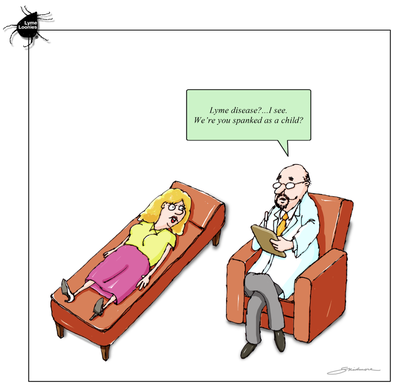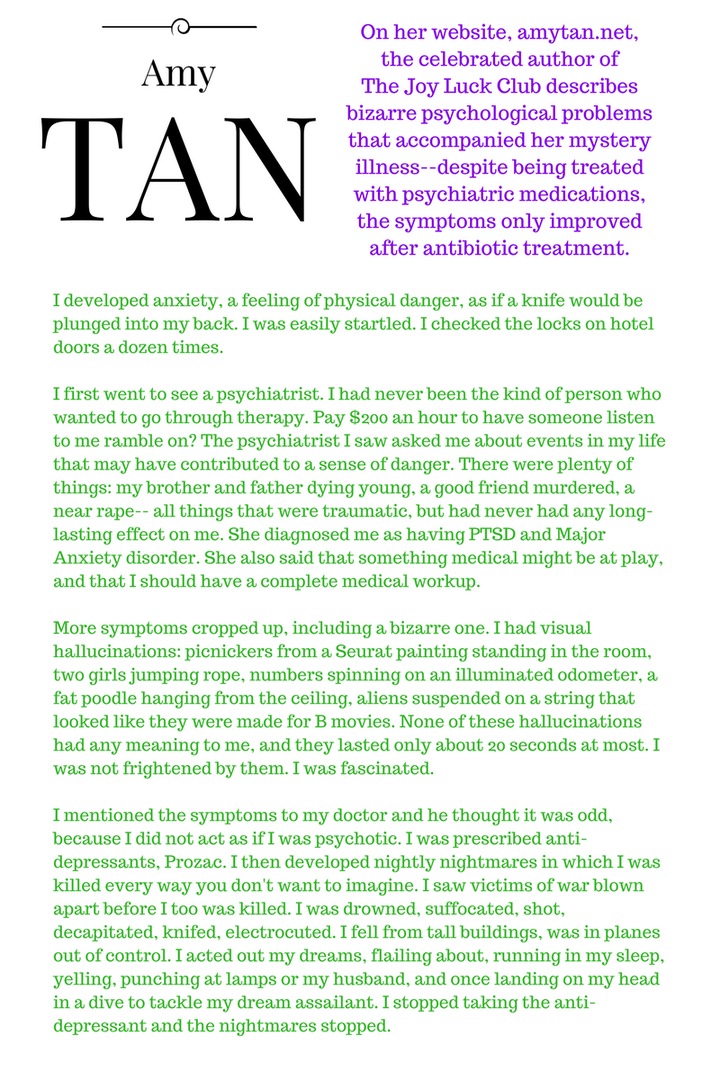I’m going to be brutally honest. Some people who have Lyme disease are crazy.
I should know. Before I was diagnosed and treated, my baseline of “a little eccentric” became a full-on “something is wrong with that dude.” I’ve always been shy—but suddenly in my mid-20s, I was terrified of people. During grad school, I developed sudden social anxiety to the extent I sometimes sat in my car and hyperventilated, even cried from confusion and self-disappointment, outside of a professor’s or a friend’s house where a party was going on. And then I would drive away feeling like an absolute failure. This was only the beginning.
Within five years, I couldn’t be in a room with strangers without going into a panic. I had always been a night owl, but I began to wake up at 5:00 a.m. on weekends so that I could go to the grocery store before the crowds arrived. I suddenly felt like people were staring at me. Not long after this inexplicable paranoia set in, I started to get a terrifying mental vision—like a short film reel playing on a loop, whether I was conscious or asleep—of my body falling off the roof of my apartment building. This, added to the frustration of doctors not being able to do anything for the severe nerve and joint pain I was having, sent me to a psychiatrist. This doctor immediately medicated me with Wellbutrin, Zoloft and Klonopin, and eventually added in a low 25 mg. dose of the atypical antipsychotic Seroquel, she said, so that I could get better-quality sleep. I was worried she had put me on it because I had a more severe mental illness than she’d disclose, but I took it because, well, I knew I was losing my mind. I once walked by this doctor’s office four times—somewhere I had gone regularly for years—without being able to recognize it. I knew it was near the 7-Eleven...but I just couldn’t find the office (which is directly next door to the 7-Eleven). My doctor thought that this behavior was due to anxiety...more Klonopin!
Not long afterward, driving to visit my parents (whose house I had lived in for a decade), I realized that my mind had wandered absently and I had apparently driven...somewhere that I didn’t recognize. It dawned on me as I drove through a housing development that I could have been a mile or two off course, or I could be an hour off course. I just couldn’t think. I pulled over to calm myself down. I looked at the clock on my phone but couldn’t remember what time I had left. I looked around and gazed at a street sign. The name was familiar. Slowly it dawned on me that this street was a block from my parents’ house. I hadn’t drifted off course at all, but I had somehow fazed out and when I came to everything looked unfamiliar to me.
I drove to my parents’ house in a panic...but what could I tell them? That I feel like I have Alzheimer’s at age 34? On top of all the excruciating nerve and joint pain? Maybe I do belong in the loony bin, I thought...

Author and artist David Skidmore channeled his frustrations about life with Lyme disease into a comic strip called Lyme Loonies (named for a term used by an NIH official who was charged with Lyme disease, as discovered via a Freedom of Information Act request). Lyme Loonies (Amazon)
I’ve seen my psychiatrist regularly since 2010, and this doctor has helped me immensely over time with cognitive-behavioral therapy. She saw me through countless, fruitless referrals to various specialists, and her investment in my well being was made evident when she seemed almost as happy as I was ultimately to make the dubious progress of various medical diagnoses: a neurologist noted abnormally brisk knee-jerk reflexes with clonus that were “worrisome”; a neuro-ophthalmologist observed a blurry optic disc margin; then I was diagnosed with cluster headaches and then with Meniere’s disease—hard-won diagnoses after over five years of seeing an endless cycle of specialists and suffering painful, confusing, depressing and often humiliating health problems.
A cluster headache may sound like a migraine, but there’s a reason it is also called a “suicide headache.” Some neurologists have speculated that the pain may be the worst that could possibly be felt by a human being. (No, really.) When my mother asked me what was wrong as we sat at the Thanksgiving dinner table, within seconds I was clasping my right eye and then up on my feet, running from the table, running around the house wailing in pain for 45 minutes. All the while, I alternately thought, God, kill me! And thinking, if you don’t die from this your family is totally sending you to the nuthouse because from the outside you look full-on insane as you run around like a literal human version of the proverbial chicken with its head cut off. Something about the pain makes most people walk quickly in circles, figure-eights, anywhere—you just have to keep moving, moving, moving. It’s not even that moving around diminishes the pain; it just accompanies the pain.
Sometimes when Lyme disease isn’t making you crazy, the crazy symptoms it may cause with no apparent rhyme or reason can at least make you look dangerously insane. One of my cluster headaches happened while I was at work. As my legs carried me into the hallway, an approaching coworker looked at me, her mouth agape, and said, “My GOD, what’s WRONG with you?!” Snot was pouring out of my right nostril, my right eyelids were dropping and my eye was evidently bright red. I couldn’t stop to explain. I had to keep moving.
Below is what a cluster headache attack looks like. It looks crazy—it’s pure, unadulterated pain. My best description of it is how I imagine a live electrical wire pushed into and pulled out of an eyeball for 45 - 90 minutes would feel. That sounds bad—and it can’t be worse than the pain of a cluster headache. While this bizarre condition is well-described and accepted in the medical community, few of us could honestly say that if we saw a person on the street in this condition, we wouldn’t turn around and head in the other direction in a hurry. It’s a physical illness that outwardly presents as, well, scary.
And Meniere’s disease—oh, let me tell you about that. A former roommate of mine was visiting from Africa, and we met at Busboys and Poets one beautiful Sunday morning for brunch. I was excited to see her. I took a bite of my eggs and suddenly felt hot, and then nauseated. This had happened twice before, and I knew what was coming. I told my friend we needed to leave immediately. Before we could ask for the check, I had almost no sense of gravity. The restaurant spun around me. My friend hoisted me up and walked me to the bathroom where I threw up, and then to her car, where I threw up more and more, and then drove me two blocks to my apartment, in front of which I threw up. She walked me upstairs and I took up residence in the bathroom for a couple of hours, praying, again, for God to take my life in equal measure because of the suffering of this at the time undiagnosed condition and also because I knew how freaking crazy I looked.
And, to be honest, how crazy I felt.
Life made no sense, and it only got worse until I finally was diagnosed with Lyme disease and began treatment. Five or six months into antibiotic treatment, my Meniere’s disease symptoms—both the sudden-onset vertigo and the severe (and supposedly progressive) hearing loss and tinnitus in my left ear improved immensely. I thought I might be deaf within a decade, and now I can hear better than I did in my mid-20s.
To be clear, the majority of my symptoms improved tremendously once I was diagnosed with Lyme disease and Bartonella infections and treated for me. This is the case for many Lyme patients who are fortunate to find a diagnosis and who have access to treatment. And yet, even after two, five, 10 or more years of suffering with no relief and worsening symptoms that finally improve with treatment, many doctors and many more everyday people who have no experience with Lyme disease insist that the diagnosis is wrong and that the treatment is ineffective. Here’s just one comment posted by a reader in response to an article I published two days ago about the so-called “Lyme Wars”:

I don’t know this person, who on his Facebook profile describes himself as “Antitheist Intellectual Biologist Chemist Zookeeper Rockhound Fossil Hunter Skeptic Metal Beardick” (which doesn’t give me a great sense of his qualifications to render this verdict), but nevertheless his opinion is shared by many. It’s above, but I will restate that opinion for emphasis: ...scientifically unqualified patients failing to respect expertise.
I have said this before and I’m certain I’ll say it again: Given my background and my skeptical personality, I would have had great difficulty believing anyone with symptoms as nonsensical and wildly erratic as mine have been had I not lived them myself.
I would have had difficulty believing anyone who claimed that medical treatment contrary to CDC-endorsed recommendations made them better had this not been my experience.
Even so, despite my skeptical nature, I never would have had the nerve to tell anyone that his or her actual lived experience is invalid, secondary and inferior to what is written in a medical textbook and adhered to rigidly by doctors.
more knowing than the experiences of someone with his or her own body? And what would possess me to be so supremely egotistical as to proclaim boldly in a public forum that anyone’s experiences are false? At my most judgmental and self-righteous, I would assume that the person had some rare disease that was not easily diagnosed, and I certainly would have sympathy for the judgment-fueled medical gauntlet that that patient had to run.
The arrogance revealed by this disease astounds me. It’s beyond what I could imagine.
Lyme Disease and The Central Nervous System
When it’s not cured, Lyme disease can infect the central nervous system. It becomes a brain infection, causing brain lesions that can be indistinguishable from multiple sclerosis on MRIs. These lesions are physical brain damage, and in addition to it, the brain and spinal column can become inflamed, bringing about a host of physical neurological problems, as well as triggering neuro-psychiatric symptoms that may be observed by outsiders and experienced by patients as akin to severe depression and anxiety, ADHD, even bipolar disorder and schizophrenia. This is simply a matter of fact, and one that’s often overlooked, I suspect, because we still assign stigma to mental illness. But we also put mental illness into a class of its own medically speaking, and that’s a mistake.
We have a problem in contemporary medicine, and it needs to be discussed openly and resolved.
When a patient presents with mental illness, that patient is determined to be mentally ill and usually is given medications to treat the mental illness. These medications come with side effects but in cases of severe mental illnesses they also can save lives and make the patient functional again.
The problem is when the mental illness is a symptom of an underlying medical problem, but once the medical disorder has been diagnosed, the diagnostic process stops there. This leaves the root cause of the illness—both the mental manifestations and the physical ones—untreated and progressive. This is common, and it makes no sense.
There’s a vicious pejorative term, “Lyme loonies,” that has been used by at least one officer at the National Institutes of Health, according to Lymedisease.org:
It was a throwaway line in an email, as the nation’s head of research funding for Lyme disease neared retirement from the National Institutes of Health.
“I will certainly miss all of you people – the scientists,” Phillip Baker, the Lyme program officer, wrote a colleague in 2007 at the U.S. Centers for Disease Control and Prevention, “but not,” he said, “the Lyme loonies.”
Baker’s appraisal – culled from 3,000 pages of documents obtained under the Freedom of Information Act and provided to the Poughkeepsie Journal — summed up in two words what physicians and scientists who challenge official policies on Lyme disease are up against.
Not only should federal officers charged with public health not describe ill—whether mentally or physically so—people in such a way, but this individual was the program officer responsible for Lyme disease. It’s like an officer a the National Institute of Mental Health bidding farewell to the “crazies” he was forced to deal with throughout his career. No one forced him to work with mentally ill people, and anyone with such a biased attitude about the very community he serves should ever have been allowed to serve in that role.
Tomorrow I’ll discuss from a less personal perspective why this cruel dismissal of sick people isn’t only an ethical failure; it’s a scientific one. And a deadly one.
Until then, a glimpse of how Lyme disease has affected the mind of a great writer, Amy Tan...

Find me (and say hi!) on Twitter @Artistlike.
If you’d like to see more in-depth research about Lyme and associated tickborne diseases, please consider supporting my work via Patreon.
